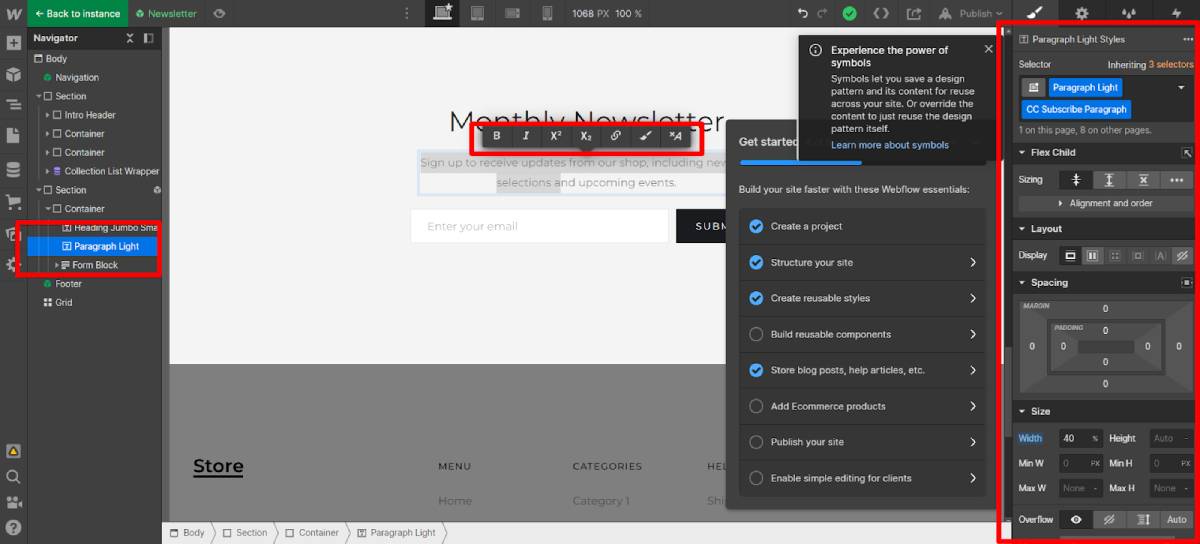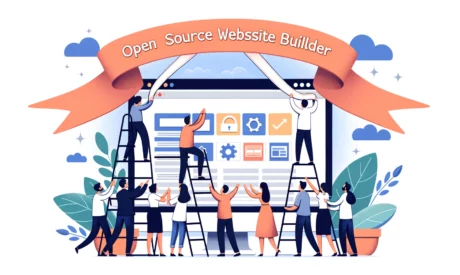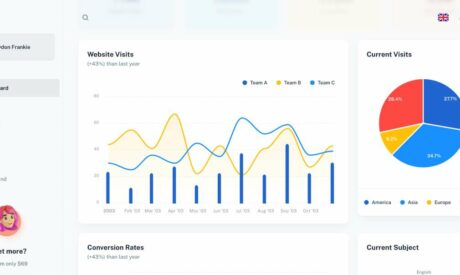The process of building websites has been revolutionized by codeless software. These not only make designing more accessible but also allow users to create professional sites without writing a single line of code.
These tools ease development by offering intuitive drag-and-drop interfaces, real-time editing capabilities, and customizable widgets. By using these platforms, businesses of all sizes can quickly establish an engaging online presence.
Understanding Codeless Development Platforms
The primary aim of zero code tools is to simplify website building and management. With intuitive graphical interfaces, these platforms allow individuals to piece together a functional and visually pleasing site effortlessly.
This approach democratizes web design by enabling more people to participate in digital creation. It quickly decreases the complexity of both constructing and sustaining websites.
The pressure for speedy deployment has driven a shift. It empowers marketers, designers, and entrepreneurs with non-technical backgrounds to take charge of site design processes. No code platforms have now become more advanced.
They offer sophisticated management, social media integration, and accessibility tools that can be deployed immediately. A variety of pre-designed templates and blocks also enable optimization for different devices.
Key Advantages of Adopting Codeless Platforms

User-Friendliness and Accessibility
Through a visual environment and real-time updates, users can quickly understand design elements and blend them with their chosen theme. The drag-and-drop feature of no code platforms also eradicates the fear users often have regarding web development.
Modern tools enable users to effortlessly pick layouts, tweak fonts, and personalize pages without worrying about the backend. This speeds up the design process and diminishes dependence on technical personnel. It also allows users to channel regular updates and adaptability based on business requirements.
Rapid Development and Deployment
Access to numerous pre-designed components and templates makes customization and integration effortless. It considerably reduces the time and resources required to launch a website. This enables enterprises to respond promptly to market shifts, guaranteeing an advantageous position in a competitive arena.
In addition, zero code tools facilitate an ongoing development approach. This allows businesses to make continuous enhancements without experiencing interruptions or delays. Consequently, companies can experiment with various functionalities and collect feedback from their audience. This approach consistently improves and doubles user engagement.
Cost-Effectiveness
Zero code tools offer significant savings by reducing development time and labor costs. Their intuitive nature also eliminates the need for specialized personnel and front-end developers. This expenditure often poses financial challenges to small and medium-sized enterprises.
The best part is that codeless platform vendors typically offer hosting and technical support as part of their subscription packages. This considerably reduces ownership expenses and ongoing costs. By bundling these services, businesses can establish a more stable framework that offers access to routine updates and safety procedures.
Flexibility and Scalability
Designed to accommodate the growth of any business, codeless software ensures websites can manage higher traffic and operations without requiring significant backend updates. This flexibility is fundamental for enterprises that expect fluctuations in volume and functionality as they grow.
In addition, businesses can easily adjust their websites to meet evolving requirements. Whether there is a need to incorporate fresh segments, supplementary payment alternatives, or interactive elements, these platforms offer a hassle-free approach. They guarantee rapid modifications without hindrance to existing processes.
Enhanced Security Features
Ensuring online safety is crucial in the face of ever-evolving threats. To counter these vulnerabilities, no code tools regularly update their security protocols. These are also usually implemented automatically, providing users top-notch protection measures without manual intervention.
Thanks to these built-in security features, businesses handling sensitive customer data can enjoy peace of mind. Consistent updates significantly reduce the workload on in-house IT teams, helping channel resources and time toward other essential business operations.
Essential Zero Code Features that Enhance User Experience
Intuitive Drag-and-Drop Builders
Codeless website development platforms heavily rely on this functionality. This beneficial feature streamlines the design process and permits users to selectively move or place any element precisely where they want it. It caters mainly to designers and marketers prioritizing aesthetics and function over technical details during website creation.
Drag-and-drop is also popular because it provides instant visual feedback. Real-time modifications accelerate the design process and decrease the errors of manual coding. Users experience a sense of power and adaptability that allows them to explore diverse layouts and find an optimal solution to their requirements.
Live Previews

Instantaneous updates enable users to preview their changes before making them permanent. This feedback is critical for optimizing user experience and ensuring all elements work together seamlessly. Quick adjustments also allow brands to comply with the latest web standards and evolving user preferences.
Live preview tools also play a crucial role in responsive design. They guarantee an exceptional appearance on all devices. Businesses can quickly witness site adaptability and performance by switching between desktop, tablet, and mobile phone views. This helps maintain user-friendliness, especially when more and more people have started browsing online via smartphones.
Seamless Third-Party Integrations
Integration with third-vendor tools has become a necessity for modern websites. Social media platforms, email marketing software, and customer relationship management systems are a few examples that are vital for boosting engagement. The good news is that no code platforms offer superb integration capabilities, guaranteeing easy connection without complex backend code.
Not only this, plug-and-play solutions enable hassle-free additions of e-commerce functionality, live chat services, and analytics tools. This effortless customization conserves resources and helps businesses stay tuned to customer needs.
Accessibility Compliance
Making websites accessible to all users, regardless of disabilities, is a moral obligation and legal requirement in many areas. Codeless platforms offer resources to ensure compliance with standards like WCAG. The Web Content Accessibility Guidelines mandate essential features like keyboard navigation, text-to-speech capability, and proper content structure to be part of optimal website design.
With accessibility tools built into their websites, businesses can quickly expand their audience reach. This also showcases a dedication to inclusivity that can significantly boost brand reputation and customer loyalty.
Advanced Customization Options
Zero coding platforms are renowned for their simplicity and pre-designed templates, but they also provide advanced personalization features for those seeking to delve deeper. These options enable users to refine designs, modify layouts, and incorporate exclusive elements that embody their brand without requiring backend knowledge.
A greater degree of customization is essential in establishing an exceptional online presence that distinguishes one from rivals. Within these platforms, users can utilize various tools to adjust colors and text to match brand persona. Some advanced platforms also grant users access to CSS and JavaScript code, offering maximum flexibility and full customization.
Comprehensive Guide to Codeless Widgets
Types and Purposes

Widgets offer a range of flexible components that enrich website functionality and interactivity without requiring intense coding. These encompass essential interface elements like image galleries or contact forms and more sophisticated features like social media feeds or e-commerce shopping carts.
Specialized engagement tools such as a no code buyback widget can be effortlessly integrated into any site to offer unique functionalities. Through wise selection and placement, businesses can turn an ordinary platform into something dynamic. A well-rounded site also quickly meets audience requirements and promotes interaction at every stage of the buyer journey.
Technical Customization
Website owners can adjust how widgets behave and interact with visitors through personalization features. Most zero code platforms offer a wide range of options, enabling the modification of both visual appearance and functional properties. These include data collection, integration with email marketing tools, or catchy action buttons. It is also possible to customize colors, fonts, and button styles.
Sophisticated customization refines load times and visibility settings to suit user patterns. These technical modifications ensure widgets complement the website's visual appeal and function smoothly. It leads to a seamless end-user experience and quickly boosts revenue.
Improving Website Performance Using Widgets
Utilizing widgets effectively can greatly enhance site performance, loading speed, and overall functionality. One exemplary technique is using lazy-loading widgets. These enable elements like images and videos to load only when visible on the viewer's screen. This significantly reduces load times and conserves bandwidth. This approach is even more critical for content-heavy or popular websites that must guarantee high speeds to incoming traffic.
In addition, certain widgets can cache data on a user's device or pre-load content ahead of time. This can significantly improve responsiveness and overall user satisfaction. The best part is that optimizing widgets for high performance also benefits SEO. This can be crucial for boosting market reach and attracting new visitors.
Security Aspects
Tools that manage user data or partner with third-party services must be configured to avoid vulnerabilities. To safeguard against potential breaches, users must obtain widgets only from trustworthy sources and keep them regularly updated.
It’s also essential to configure widgets with HTTPS and implement strong error handling plus data encryption. Prioritizing the security of widgets can prevent possible cyberattacks. This can be key to maintaining visitor trust and online reputation.
Analytics and Feedback
Using analytical widgets, brands can collect ample information regarding how users engage with their websites and understand behavior patterns. Insights into interactions with popular content can also help identify areas for improvement. Feedback through surveys or comment boxes further enables direct communication. This can quickly help businesses perceive customer satisfaction levels and address concerns promptly.
Endnote
The emergence of codeless website development platforms has revolutionized how businesses approach their online presence. These innovative tools have simplified the creation of professional-looking websites with intuitive design features, integrated functions, and advanced capabilities. As technology evolves, these platforms indicate becoming even more sophisticated. They offer an exciting prospect for all companies, regardless of size or resources.
Ludjon, who co-founded Codeless, possesses a deep passion for technology and the web. With over a decade of experience in constructing websites and developing widely-used WordPress themes, Ludjon has established himself as an accomplished expert in the field.









Comments